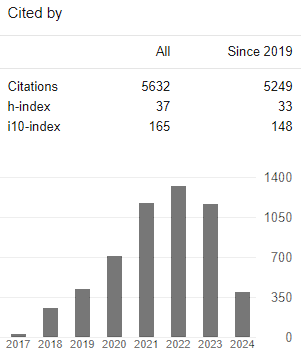The relevance of green branding on competitive strategies in service firms
Keywords:
environmental factors, firm, green branding, innovation, performanceAbstract
The study evaluated qualitatively the relevance of green branding in service firms. Drawing the manufacturing industry perspective. Two objectives were drawn for this bordering on environmental actors and green innovation as it affects competitive advantage, The extant literature revealed a strong impact of these predator variables on competitive advantage in service industry management. The findings was that the performance of green innovation, product and process has a positive influence on the performance of the firms, although green innovation process is rarely discussed in the literature, it is very important to highlight the green innovation process, as it is easy to imitate the final product, compared to the process. Recommendations were made on the need to continue to uphold green innovation and major environmental factors to promote firm performance and profitability.
Downloads
References
Apaolaza Ibáñez, V., & Hartmann, P. (2006). Green value added. Marketing Intelligence & Planning, 24(7), 673-680.
Apaolaza Ibáñez, V., Hartmann, P., & Forcada Sainz, F. J. (2005), Green branding effects on attitude: functional versus emotional positioning strategies. Marketing Intelligence & Planning, 23(1), 9-29.
Baack, D. W., & Boggs, D. J. (2008). The difficulties in using a cost leadership strategy in emerging markets. International Journal of Emerging Markets, 3(2), 125-139.
Berkhout, F. (2012). Adaptation to climate change by organizations. Wiley interdisciplinary reviews: climate change, 3(1), 91-106.
Biggar, J. M., & Selame, E. (1992). Building brand assets. Chief Executive, 78, 36-39.
Brorson, T., & Larsson G. (2006). Environmental Management, How to Implement an Environmental Management System within a Company or other Organization. Stockholm: EMS AB.
Bruce, C., & Laroiya, A. (2007). The production of eco-labels. Environmental and Resource Economics, 36(3), 275-293.
Calantone, R. J., Cavusgil, S. T., & Zhao, Y. (2002). Learning orientation, firm innovation capability, and firm performance. Industrial marketing management, 31(6), 515-524. https://doi.org/10.1016/S0019-8501(01)00203-6
Chan, C. S., Marafa, L. M., Van Den Bosch, C. C. K., & Randrup, T. B. (2018). Starting conditions for the green branding of a city. Journal of Destination Marketing & Management, 10, 10-24. https://doi.org/10.1016/j.jdmm.2018.05.006
Chan, H. K., He, H., & Wang, W. Y. (2012). Green marketing and its impact on supply chain management in industrial markets. Industrial marketing management, 41(4), 557-562. https://doi.org/10.1016/j.indmarman.2012.04.002
Chandler, G. N., & Hanks, S. H. (1993). Measuring the performance of emerging businesses: A validation study. Journal of Business venturing, 8(5), 391-408. https://doi.org/10.1016/0883-9026(93)90021-V
Chen, C. T., Lin, C. T., & Huang, S. F. (2006). A fuzzy approach for supplier evaluation and selection in supply chain management. International journal of production economics, 102(2), 289-301. https://doi.org/10.1016/j.ijpe.2005.03.009
Chen, Y. S. (2010). The drivers of green brand equity: Green brand image, green satisfaction, and green trust. Journal of Business ethics, 93(2), 307-319.
Clarke-Hill, C., Comfort, D., Hillier, D., & Jones, P. (2008). Marketing and sustainability. Marketing Intelligence & Planning, 26(2), 123-130.
Coddington, W., & Florian, P. (1993). Environmental marketing: Positive strategies for reaching the green consumer. McGraw-Hill Companies.
Day, G. S. (1989). Deciding how to compete. Planning Review.
Dewi, I. A. M. C., Sari, M. M. R., Budiasih, I., & Suprasto, H. B. (2019). Free cash flow effect towards firm value. International Research Journal of Management, IT and Social Sciences, 6(3), 108-116. https://doi.org/10.21744/irjmis.v6n3.643
Doyle, P., & Stern, P. (2006). Marketing management and strategy. Pearson Education.
Farnsworth, E. (2000). The ecology and physiology of viviparous and recalcitrant seeds. Annual review of ecology and systematics, 107-138.
Fraj, E., Martínez, E., & Matute, J. (2011). Green marketing strategy and the firm's performance: the moderating role of environmental culture. Journal of Strategic Marketing, 19(4), 339-355.
Ghodeswar, B. M. (2008). Building brand identity in competitive markets: a conceptual model. Journal of product & brand management, 17(1), 4-12.
Glaser, S. (2017). A review of spatial econometric models for count data.
Grant, A. M. (2007). Relational job design and the motivation to make a prosocial difference. Academy of management review, 32(2), 393-417.
Insch, A. (2011). Ethics of place making. Place branding and public diplomacy, 7(3), 151-154.
Juwaheer, T. D., Pudaruth, S., & Noyaux, M. M. E. (2012). Analysing the impact of green marketing strategies on consumer purchasing patterns in Mauritius. World Journal of Entrepreneurship, Management and Sustainable Development.
Kaynak, H. (2003). The relationship between total quality management practices and their effects on firm performance. Journal of operations management, 21(4), 405-435. https://doi.org/10.1016/S0272-6963(03)00004-4
Kroeber-Riel, W. (1991). Kommunikationspolitik: Forschungsgegenstand und Forschungsperspektive. Marketing: Zeitschrift für Forschung und Praxis, 164-171.
Laufer, W. S. (2003). Social accountability and corporate greenwashing. Journal of business ethics, 43(3), 253-261.
Leonidou, L. C., Leonidou, C. N., Fotiadis, T. A., & Zeriti, A. (2013). Resources and capabilities as drivers of hotel environmental marketing strategy: Implications for competitive advantage and performance. Tourism management, 35, 94-110. https://doi.org/10.1016/j.tourman.2012.06.003
Miles, M. P., & Covin, J. G. (2000). Environmental marketing: A source of reputational, competitive, and financial advantage. Journal of business ethics, 23(3), 299-311.
Minoja, M., Zollo, M., & Coda, V. (2010). Stakeholder cohesion, innovation, and competitive advantage. Corporate Governance: The international journal of business in society.
Nagra, V. (2010). Environmental education awareness among school teachers. The Environmentalist, 30(2), 153-162.
Peattie, K. (2001). Towards sustainability: the third age of green marketing. The marketing review, 2(2), 129-146.
Polonsky, M. J. (1994). An introduction to green marketing. Electronic green journal, 1(2).
Prajogo, D. I. (2007). The relationship between competitive strategies and product quality. Industrial management & data systems.
Ramus, C. A., & Montiel, I. (2005). When are corporate environmental policies a form of greenwashing?. Business & Society, 44(4), 377-414.
Rex, E., & Baumann, H. (2007). Beyond ecolabels: what green marketing can learn from conventional marketing. Journal of cleaner production, 15(6), 567-576. https://doi.org/10.1016/j.jclepro.2006.05.013
Rodríguez-Ibeas, R. (2006). Environmental regulatory enforcement with “green” consumers. Spanish Economic Review, 8(4), 271-283.
Rothwell, R. (1991). External networking and innovation in small and medium-sized manufacturing firms in Europe. Technovation, 11(2), 93-112. https://doi.org/10.1016/0166-4972(91)90040-B
Schleicher, K. (1989). Beyond environmental education: The need for ecological awareness. International Review of Education, 35(3), 257-281.
Shane, S. (1993). Cultural influences on national rates of innovation. Journal of business venturing, 8(1), 59-73. https://doi.org/10.1016/0883-9026(93)90011-S
Siegenthaler, M. (2012). A view on the long-run evolution of hours worked and labor productivity in Switzerland (1950–2010).
Srivastava, S. K. (2007). Green supply?chain management: a state?of?the?art literature review. International journal of management reviews, 9(1), 53-80.
Thompson, K. N., & Coe, B. J. (1997). Gaining sustainable competitive advantage through strategic pricing: selecting a perceived value price. Pricing strategy and practice.
Thompson, K. N., & Coe, B. J. (1997). Gaining sustainable competitive advantage through strategic pricing: selecting a perceived value price. Pricing strategy and practice.
Tjärnemo, H. (2001). Eco-marketing & Eco-management. Exploring the eco-orientation-performance link in food retailing.
Walker, R. H., & Hanson, D. J. (1998). Green marketing and green places: A taxonomy for the destination marketer. Journal of Marketing Management, 14(6), 623-639.
Walters, D., & Lancaster, G. (2000). Implementing value strategy through the value chain. Management Decision, 38(3), 160-178.
Walters, D., & Rainbird, M. (2004). The demand chain as an integral component of the value chain. Journal of consumer marketing.
Welford, R. (1998). Corporate strategy, competitiveness and the environment. Corporate Environmental Management, 1, 13-34.
Wever, G. (1996). Strategic environmental management: Using TQEM and ISO 14000 for competitive advantage (Vol. 2). John Wiley & Sons.
Published
How to Cite
Issue
Section
Copyright (c) 2022 International research journal of management, IT and social sciences

This work is licensed under a Creative Commons Attribution-NonCommercial-NoDerivatives 4.0 International License.
Articles published in the International Research Journal of Management, IT and Social sciences (IRJMIS) are available under Creative Commons Attribution Non-Commercial No Derivatives Licence (CC BY-NC-ND 4.0). Authors retain copyright in their work and grant IRJMIS right of first publication under CC BY-NC-ND 4.0. Users have the right to read, download, copy, distribute, print, search, or link to the full texts of articles in this journal, and to use them for any other lawful purpose.
Articles published in IRJMIS can be copied, communicated and shared in their published form for non-commercial purposes provided full attribution is given to the author and the journal. Authors are able to enter into separate, additional contractual arrangements for the non-exclusive distribution of the journal's published version of the work (e.g., post it to an institutional repository or publish it in a book), with an acknowledgment of its initial publication in this journal.
This copyright notice applies to articles published in IRJMIS volumes 7 onwards. Please read about the copyright notices for previous volumes under Journal History.












